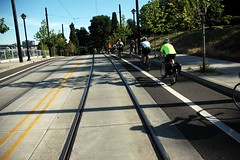[This is the second (and final) part of our In-Depth report by Libby Tucker on how bikes fit into Portland’s streetcar plans. Read the first installment here.]
Yesterday, we left off with a discussion about bikeway and streetcar track design in the Pearl District. Mia Birk, a former bike coordinator for the City of Portland and now a consultant on Portland’s streetcar plans, continues our story…

routed up onto the sidewalk
to get around the streetcar
platform. (Photos © J. Maus)
The Lovejoy design (see photo at right) creates a “very uncomfortable situation for most bicyclists,” added Birk. “It feels really weird to go up on the sidewalk and blast through a pedestrian zone, and when you’re on the street you have to cross tracks at a bad angle.”
This time, Alta (the planning firm where Birk is a principal) has completely redesigned the Pearl District’s bike facilities in the area surrounding the streetcar tracks, starting with the removal of the bike lane on Lovejoy. Instead, the streetcar plan would convert Lovejoy and Northrup into a one-way couplet for cars and reroute bike traffic onto a bike boulevard along Northwest Marshall. The cobblestone street would be smoothed out to accommodate bikes and would include new bike signals and bike boxes along the route.
“That was the first time the city agreed to give up a bike lane it already has. That’s a very significant statement of trust to believe it would be better for bikes than to keep the lane. That’s a mark of maturing as a real part of our system.”
— Rick Gustafson, executive director of Portland Streetcar Inc.
“That was the first time the city agreed to give up a bike lane it already has,” said Gustafson, who’s still looking for a way to pay for the proposed bike improvements in the Pearl. “That’s a very significant statement of trust to believe it would be better for bikes than to keep the lane. That’s a mark of maturing as a real part of our system.”
“Absent a strong city and regional policy saying cycle tracks and bicycling is really important to the future, it’ll take a while. These are major changes to our street system and they get a lot of resistance.”
— Rex Burkholder, Metro Councilor
The second area of focus was the Lloyd District where preliminary designs for the streetcar along Northeast 7th Avenue sandwiched a bike lane between the tracks and a row of parked cars. A redesign led to plans for a raised cycle track along 7th between Weidler and Northeast Irving Street that would physically separate the bike lane from the roadway.
The problem is, the plan still doesn’t include a connection from the Lloyd District to the central eastside, said Birk. In essence, the cycle track doesn’t go anywhere.
The streetcar planning committee considered options beyond the Lloyd District, where the streetcar route extends along MLK and Grand, but decided against including bike facilities despite a last-minute plea from Metro Councilor Rex Burkholder. In a Nov. 19 letter to then-Commissioner Sam Adams (download it here, 28k PDF), Burkholder outlined a vision of installing a cycle track on MLK and Grand. But the plan would have cut a lane of car traffic on a designated freight route and infuriated the business community, said Gustafson.
“Absent a strong city and regional policy saying cycle tracks and bicycling is really important to the future, it’ll take a while,” said Burkholder. “These are major changes to our street system and they get a lot of resistance.”
In the meantime, Metro is almost finished with a new transportation planning model that will consider bike trips as well as car trips in multimodal street design. Current models account for changes in car traffic as a result of the streetcar tracks but can’t predict the reduction in traffic that could result from improved bicycling facilities that could entice more people out of their cars, said Burkholder. Metro will begin testing the new models next month and plans to roll them out for all its projects this summer – that’s still too late for the eastside streetcar, however.
“When we step back, every single one of those rail lines should be designed with the idea that cyclists will be in that corridor, that’s really what we should have done,” said Birk. “The elephant in the room is King and Grand; I’m very sad a bike lane or cycle track hasn’t been part of the project.”
— Read Part One of this story here. For more of our special, In-Depth news reports, visit our In-Depth News archives.


